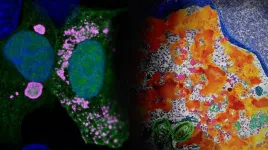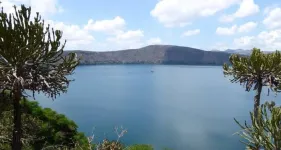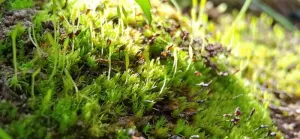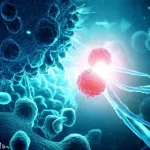(Press-News.org) A telecommunications fiber optic cable deployed offshore of Oliktok Point, Alaska recorded ambient seismic noise that can be used to finely track the formation and retreat of sea ice in the area, researchers report in The Seismic Record.
Andres Felipe Peña Castro of the University of New Mexico and colleagues used distributed acoustic sensing, or DAS, to identify seismic signals related to the motion of waves on open water and the sea ice that suppresses that wave action. The technique offers a way to track sea ice with increasing spatial and temporal resolution—on the scale of hours and kilometers--compared to satellite images that are updated daily and may cover tens to hundreds of kilometers.
Swiftly monitoring sea ice changes is important to commercial shipping as well as Native communities and could become another useful tool in tracking Arctic climate change, the research team noted.
In the TSR study, the scientists were able to observe abrupt changes in sea ice extent up to 10 kilometers that occurred in less than a day.
“It was definitely surprising that the sea ice can change so much in a few hours,” said Peña Castro. “A few colleagues have mentioned that these rapid changes may be common but the temporal resolution of satellites makes it rare to observe such rapid changes in sea ice.”
DAS uses the tiny internal flaws in a long optical fiber as thousands of seismic sensors. An instrument called an interrogator at one end of the fiber sends laser pulses down the cable that are reflected off the fiber flaws and bounced back to the instrument. Researchers can examine changes in the timing of the reflected pulses to learn more about the resulting seismic waves.
Peña Castro and colleagues used a 37.4-kilometer-long section of seafloor fiber optic cable, part of a network owned by Quintillion Global and not actively carrying telecom data, in their DAS experiment. The DAS data were recorded between 9-15 July 2021 and 10-16 November 2021, times that were specifically targeted to capture periods of transitional sea ice coverage.
The original idea, said Peña Castro, was to classify different signals emerging from the interaction of ocean, earth and atmosphere, such as potential local sea state and storm surges, shoaling and sea ice fracturing. “We wanted to objectively identify the major types of signals in the data without assuming how many signals or which signals would be dominant,” he said. “We did not expect to observe changes in sea ice cover with such fine spatiotemporal detail.”
The researchers turned to machine learning algorithms to sort through the massive fiber optic data set. “In general, DAS generates large amounts of data that are impossible to process manually and that’s why we opted to use a machine learning approach that can identify possible patterns in the data,” Peña Castro explained. “Once a signal or pattern has been identified then we can consider how to track that signal most efficiently.”
The researchers were able to observe the formation of sea ice along the length of the cable, but not how far the ice spread perpendicular to the cable. They did not measure sea ice thickness in the TSR study, but Peña Castro said “in theory it is possible to determine ice thickness using DAS. One difficulty is that ground truth measurements of ice thickness are necessary to validate proposed methods.”
The combination of machine learning and DAS techniques is already being used in the oil and gas industry, said Peña Castro. “In general, clustering techniques such as those used in this study may help identify lots of different types of change in environmental or anthropogenic signals that create ground vibrations.”
.
END
Telecommunications cable used to track sea ice extent in the Arctic
2023-08-09
ELSE PRESS RELEASES FROM THIS DATE:
Playing catch-up on weekends may not improve cardiovascular cost of sleep loss
2023-08-09
UNIVERSITY PARK, Pa. — Whether it’s work or play that prevents us from getting enough shut-eye during the week, assuming we can make up for it by sleeping in over the weekend is a mistake. New research led by Penn State reveals that cardiovascular health measures, including heart rate and blood pressure, worsen over the course of the week when sleep is restricted to five hours per night, and attempting to catch up on sleep over the weekend is insufficient to return these measures to normal.
“Only 65% of adults in the U.S. regularly sleep the recommended seven hours per night, ...
A new look inside Ebola's 'viral factories'
2023-08-09
LA JOLLA, CA—New research in the journal Nature Communications gives scientists an important window into how Ebola virus replicates inside host cells. The study, led by scientists at La Jolla Institute for Immunology (LJI), reveals the inner workings of "viral factories," clusters of viral proteins and genomes that form in host cells.
The research team, which included experts from Scripps Research and UC San Diego School of Medicine, found that Ebola virus's replication machinery forms fascinating microscopic ...
Exercise apps a good prescription to boost healthcare workers' mental health
2023-08-09
Simple home workouts using exercise apps can effectively reduce depressive symptoms in healthcare workers and could be a major tool to combat the global mental health crisis in the sector, says new University of British Columbia research.
The study, published today in JAMA Psychiatry, divided participants into either a waitlisted control group or an exercise group who were given free access to a suite of home exercise apps called DownDog, that included yoga, cardio and strength training. They were asked to aim for at least 80 minutes of moderate-intensity ...
Then vs. now: Did the Horn of Africa reach a drought tipping point 11,700 years ago?
2023-08-09
New research suggests that the Horn of Africa is likely to become even drier, not wetter in the future as predicted by most climate models.
‘Wet gets wetter, dry gets drier’. That mantra has been used for decennia to predict how global warming will affect the hydrological cycle in different world regions. But if climate models predict that much of tropical Africa will enjoy a future with wetter weather, then why does it keep getting drier in certain parts of the African tropics, like the Horn of Africa? An international team of researchers ...
Resilient biomedical scientists’ careers took a hit during pandemic
2023-08-09
First study to measure resilience in biomedical scientists during the pandemic
Sixty-one percent of study participants said they experienced a setback during pandemic
‘You can be as resilient as you want, but certain structural factors can hinder your professional advancement’
CHICAGO --- When COVID-19 presented the world with the greatest health challenge in modern history, it was biomedical scientists who stepped up to develop diagnostic testing and vaccines to slow the spread of the disease.
But how did these in-demand scientists fare psychologically and in their careers amid pandemic pressures such as juggling ...
Engineered probiotic developed to treat multiple sclerosis
2023-08-09
Brigham researchers are working on a new approach to target autoimmunity in the brain leverages designer bacteria to make treatment safer and more effective
Researchers from Brigham and Women’s Hospital, a founding member of the Mass General Brigham healthcare system, have designed a probiotic to suppress autoimmunity in the brain, which occurs when the immune system attacks the cells of the central nervous system. Autoimmunity in the brain is at the core of several diseases, including multiple sclerosis. In a new study, researchers demonstrated the treatment’s potential using preclinical models of these diseases, finding that the technique offered a more precise ...
There and back again: how neurons make room for growth in a developing organ
2023-08-09
To function properly, organs require a precise number of cells and a functional architecture, which are established during embryogenesis. Embryos are proficient multitaskers; they grow, and acquire shape and functional architecture all at once. Despite a lot of research on embryo development, scientists do not yetfully grasp how embryos orchestrate all these different tasks in space and time to ensure the formation of healthy organs. This was ...
Oldest extant plant has adapted to extremes and is threatened by climate change
2023-08-09
The rare moss Takakia has adapted over millions of years to a life at high altitudes. An international research team led by Prof. Dr. Ralf Reski from the University of Freiburg and Prof. Dr. Yikun He from the Capital Normal University / China has now discovered exactly how it has developed the ability to survive frost and life-threatening high UV radiation. In the renowned journal Cell, they describe the genetic traits that protect the moss from extreme environmental conditions. At the same time, they document how climate change greatly altered the natural habitat of this highly specialized species within just a few years.
The ...
Drinking alcohol not likely to increase risk of a breast cancer recurrence
2023-08-09
A Kaiser Permanente study provides new information that may help oncologists answer one of the most common questions they hear from breast cancer survivors: Is it safe to drink alcohol?
The new study, published August 9 in Cancer, is the largest prospective study to look at short-term alcohol use after breast cancer. The findings suggest drinking alcohol is not associated with an increased risk of breast cancer recurrence or dying from the disease.
“We know that women who drink alcohol are at increased ...
New machine-learning method may aid personalized cancer therapy
2023-08-09
FOR IMMEDIATE RELEASE
Deep-learning technology developed by a team of Johns Hopkins engineers and cancer researchers can accurately predict cancer-related protein fragments that may trigger an immune system response. If validated in clinical trials, the technology could help scientists overcome a major hurdle to developing personalized immunotherapies and vaccines.
In a study published July 20 in the journal Nature Machine Intelligence, investigators from Johns Hopkins Biomedical Engineering, the Johns Hopkins Institute for Computational Medicine, the Johns Hopkins Kimmel Cancer Center and the Bloomberg~Kimmel Institute for Cancer Immunotherapy show that ...




